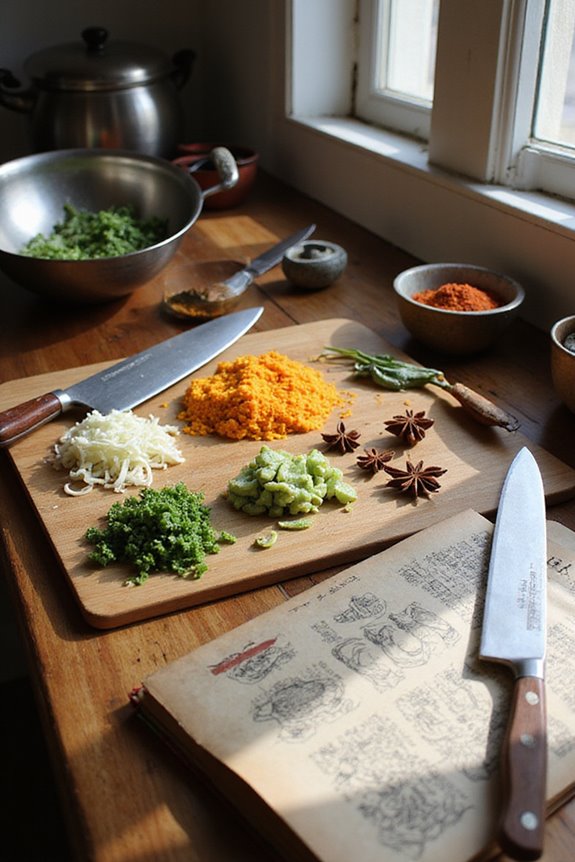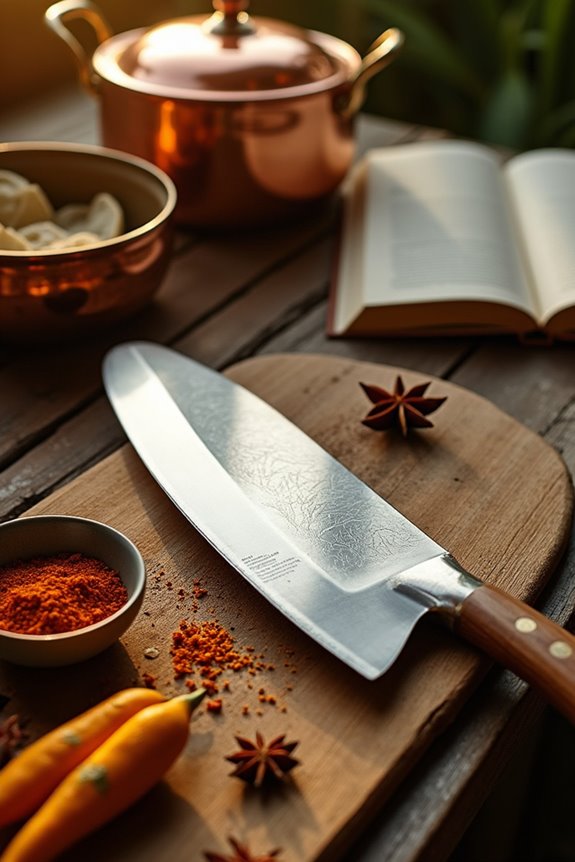Mastering essential knife cuts is magical for our Asian cooking journey! We should focus on key techniques like diagonal cuts for flavor bursts and julienne cuts for that delightful crunch. Don’t forget about precise thin sheet cuts and cylinder cuts for perfect veggie presentation. It’s all about safety too, with a proper grip and controlled motions. With these skills, our dishes will surely impress! Stick around and we’ll uncover even more exciting tips and techniques together!
Key Takeaways
- Thin Sheet Cut (Katsuramuki): Creates ultra-thin sheets from vegetables, essential for presentation and texture in dishes.
- Diagonal Cuts: Increases flavor absorption and enhances the overall taste profile of stir-fried dishes.
- Julienne Cuts: Provides crunchy texture to vegetables like carrots, adding visual appeal and taste in recipes.
- Dicing Vegetables: Ensures even cooking and a festive presentation, crucial for stir-fries and soups.
- Chopping Onions and Garlic: Enhances aroma and flavor, forming the base for many Asian dishes.
Common Knife Types for Asian Cooking
When it comes to Asian cooking, having the right tools makes all the difference—kind of like bringing the perfect dish to a potluck! Let’s explore some essential knife types that can elevate our culinary game:
- Gyuto: The classic all-rounder, great for everything from meat to veggies!
- Santoku: This versatile knife excels at slicing, dicing, and chopping—perfect for our busy kitchens.
- Nakiri: With its straight edge, this beauty’s a veggie pro, giving us precise cuts.
- Bunka: A hybrid marvel, ideal for detailed work and those charming push cuts.
Additionally, a well-balanced knife not only enhances precision cutting but also reduces fatigue during prolonged use, making it a valuable tool in the kitchen.
Essential Knife Cuts: Thin Sheet and Cylinder Cuts

Knife skills can open up a whole new world of possibilities in our cooking adventures—it’s like finding the perfect gift at a holiday party! One magical cut we can master is the thin sheet cut (Katsuramuki). It involves peeling veggies, like daikon or cucumber, into ultra-thin sheets. Just remember to keep that knife sharp for the smoothest slice!
Next, let’s tackle cylinder cuts. We can trim our cylindrical vegetables into manageable lengths before slicing. This helps us achieve even cuts and sets us up for success with thin sheets or julienne strips. So grab your Japanese knife, stabilize with a non-cutting hand, and let’s create delightful dishes that impress at any gathering! Happy slicing, friends! Incorporating a balance of sharpness in your knives will significantly enhance your precision in these techniques.
Fundamental Vegetable Cuts for Stir-fries and Soups
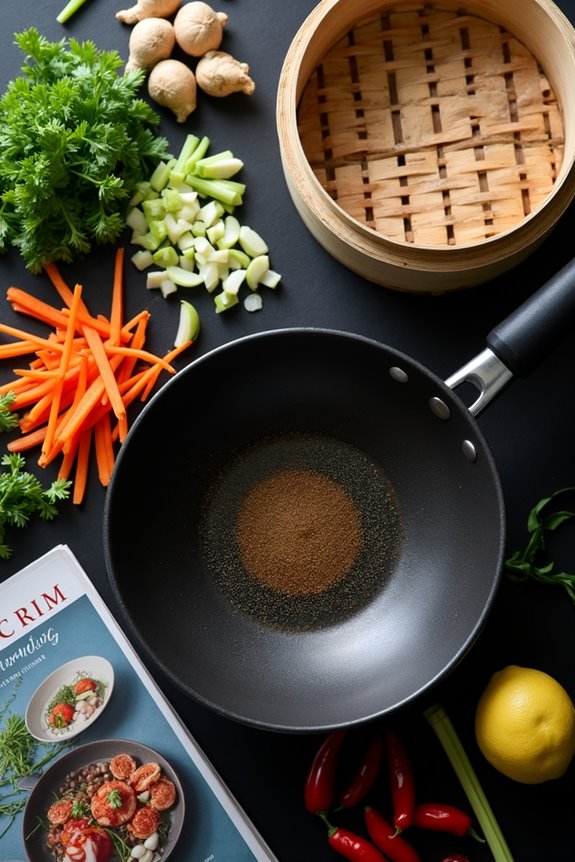
Stir-frying and making soups are like hosting a delicious holiday party, where fundamental vegetable cuts play the starring roles! To guarantee our dishes shine, we should master a few essential stir fry techniques for vegetable preparation.
- Diagonal Cuts boost flavor absorption.
- Julienne cuts for carrots add delightful crunch.
- Dicing vegetables guarantees even cooking for a festive feel.
- Slicing bell peppers brings vibrant color to our party platter.
- Chopping onions and garlic enhances aroma!
These techniques make our meals not just tasty but also visually enchanting. In fact, mastering these cutting techniques can significantly enhance your overall cooking experience and efficiency. Remember, practice makes perfect! So, let’s grab our trusty knives and start creating those delightful veggie cuts that will make every stir-fry or soup a hit at our culinary celebrations!
Meat and Mincing Techniques
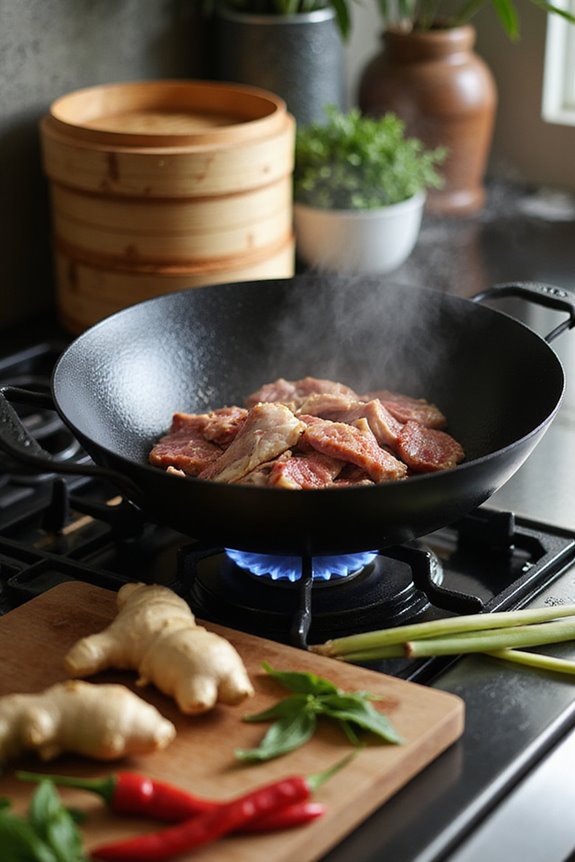
For those irregular shapes, embrace the rolling cut! Make that first angled cut and rotate the meat to keep it consistent, ensuring it cooks evenly—especially handy for those stir-fries! Now, when mincing for dumplings or meatballs, a sharp knife paired with a rocking motion does wonders. A quality knife with high carbon stainless steel provides durability and sharpness, enhancing your mincing efficiency. Let’s explore these techniques together and elevate our cooking game—culinary magic awaits!
Safety and Proper Handling Techniques
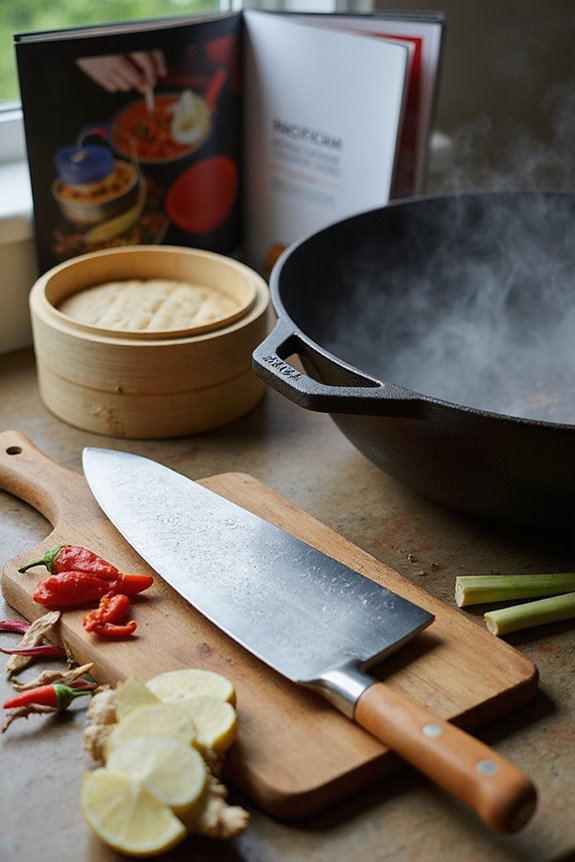
When we immerse ourselves in the delightful world of Asian cooking, safety and proper handling techniques are just as important as the ingredients we choose! To master our knife grip, we should pinch the blade’s base with our index finger and thumb for stability. Let’s keep our fingers curled in a “claw” position to guide against the blade, ensuring our fingertips stay tucked for cutting safety.
Use controlled, deliberate motions and never cut towards ourselves—let’s keep the magic of cooking accident-free! Always store knives safely, using designated storage to prevent slips. Remember that a sharp knife**** is our friend; it makes cuts easier and safer. Let’s embrace these techniques and create some culinary wonders together!
Basic Knife Cuts to Master for Asian Cuisine
Mastering basic knife cuts in Asian cuisine opens up a delightful world of flavors and textures. Let’s jump into the magic of knife skills! Here are some essential cuts to master for ingredient preparation:
- Katsuramuki: Create thin sheets from cucumbers—perfect for sushi!
- Push Cut: Slice with precision for stir-fries.
- Julienne: Make matchstick veggies for salads—fancy, right?
- Chop/Rock-Chop: Quick, forceful cuts for robust ingredients.
Don’t forget that consistent, uniform cuts help guarantee even cooking. Practice slowly and safely, and soon you’ll impress everyone with your magical culinary skills. So grab that Chuka Bocho cleaver, and let’s get slicing! The kitchen’s where the fun happens! Remember, having the right essential utensils can elevate your cutting and cooking experience.
Frequently Asked Questions
What Is the Best Knife for Beginners in Asian Cooking?
When we’re starting our journey in Asian cooking, choosing the right beginner knives is essential. We’ll find that lightweight designs enhance our knife handling, helping us build confidence and refine our skills in the kitchen.
How Do I Maintain My Kitchen Knives Properly?
How do we keep our kitchen knives in top shape? By mastering knife sharpening and regular maintenance, we guarantee our cutting techniques stay sharp. Together, let’s make cooking enjoyable by caring for our beloved tools!
Can I Use Non-Asian Knives for Asian Cooking?
Absolutely, we can use non-Asian knives for Asian cooking! By mastering various knife types and adapting our cutting techniques, we’ll achieve great results, enjoying the process together while embracing culinary creativity in the kitchen.
What Knife Cuts Are Essential for Sushi Preparation?
When we immerse ourselves in sushi slicing techniques, mastering fish preparation methods is essential. Together, we can explore cuts like hira-zukuri and usuzukuri—enhancing our skills and savoring the art of sushi-making as a community.
How Do Different Knife Blade Materials Affect Performance?
When we consider different knife blade materials, we find that blade durability directly impacts cutting precision. A sharp, well-maintained blade not only enhances our cooking experience but also brings us together in our culinary journeys.

